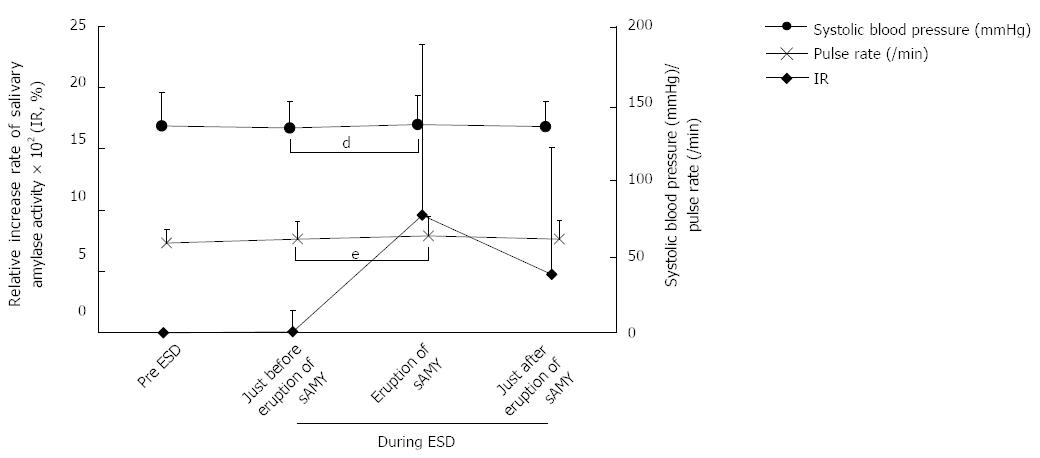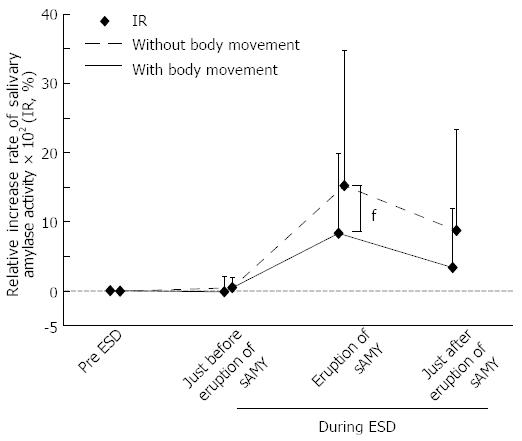Copyright
©2014 Baishideng Publishing Group Inc.
World J Gastrointest Endosc. Jun 16, 2014; 6(6): 240-247
Published online Jun 16, 2014. doi: 10.4253/wjge.v6.i6.240
Published online Jun 16, 2014. doi: 10.4253/wjge.v6.i6.240
Figure 1 Changes in the relative rate of increase of the salivary amylase activity level compared with the control level, salivary amylase activity (IR, %), and the bispectral index around the 26 episodes of salivary amylase activity elevation in the H-group.
The baseline level of sAMY significantly increased in association with an IR of > 100% at only 5 min, with a significant difference (IR immediately before elevation/IR at elevation of sAMY = 8.72 ± 173/958 ± 1391%, aP < 0.001). However, the release of gastric wall tension and/or pentazocine injection effectively decreased the elevated sAMY level immediately within only 5 min with a significant difference (IR at sAMY elevation/immediately after intervention = 958 ± 1391/476 ± 1031, bP < 0.001). The bispectral indices in the patients undergoing ESD proved to be stable throughout the procedures (cP = 0.272), even when the sAMY level was elevated in association with an IR of > 100%, i.e., when the patient received SE. All 14 patients responded with “I did not wake up at all” on the post-ESD questionnaire. The data are presented as the mean ± SD. ESD: Endoscopic submucosal dissection; DS: Deep sedation; sAMY: Salivary amylase activity; SE: Sympathetic excitement; H-sAMY: A high value of salivary amylase activity; L-sAMY: A low value of salivary amylase activity.
Figure 2 Changes in the relative rate of increase of the salivary amylase activity level compared with the control level, salivary amylase activity (IR, %), the systolic blood pressure (mmHg) and pulse rate (/min) around the 26 episodes of salivary amylase activity elevation in the H-group.
The values of systolic blood pressure and pulse rate also remained stable during ESD, regardless of the change in the sAMY (dP = 0.660 and eP =0.614, respectively). The data are presented as the mean ± SD. ESD: Endoscopic submucosal dissection; DS: Deep sedation; sAMY: Salivary amylase activity; SE: Sympathetic excitement; H-sAMY: A high value of salivary amylase activity; L-sAMY: A low value of salivary amylase activity.
Figure 3 Changes in the relative rate of increase of the salivary amylase activity level compared with the control level, salivary amylase activity (IR, %), with reference to the status of body movement in the H-group.
The levels of IR that were not associated with body movement (9 episodes) were relatively higher than those associated with body movement (17 episodes); however, no significant differences were observed (fP = 0.236). The patients received SE shown as the elevation of sAMY, even if they were unconscious and exhibited no body movement. The management of the sAMY might prevent the patient’s body movement that may occur in the near future. The data are presented as the mean ± SD. ESD: Endoscopic submucosal dissection; DS: Deep sedation; sAMY: Salivary amylase activity; SE: Sympathetic excitement; H-sAMY: A high value of salivary amylase activity; L-sAMY: A low value of salivary amylase activity.
- Citation: Uesato M, Nabeya Y, Akai T, Inoue M, Watanabe Y, Horibe D, Kawahira H, Hayashi H, Matsubara H. Monitoring salivary amylase activity is useful for providing timely analgesia under sedation. World J Gastrointest Endosc 2014; 6(6): 240-247
- URL: https://www.wjgnet.com/1948-5190/full/v6/i6/240.htm
- DOI: https://dx.doi.org/10.4253/wjge.v6.i6.240











